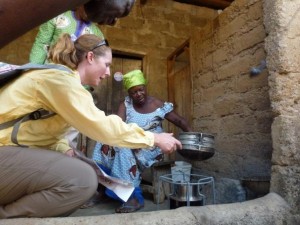Who are your role models? Why? Take a second to think of what makes a good role model in the scientific community. The first things I think of are patience and a commitment to learning, two traits that Christine Wiedinmyer exhibits. When I called Christine to ask her about her research, she was confused as to why she was being considered a community scientist. She thinks of herself as a bad role model in community science. Yet, her continued efforts to improve air quality in Navrongo, Ghana make me think otherwise. When I asked her some of the ‘do’s and don’t’s’ of community science she replied ‘patience’ and ‘really trying to understand the culture’ as two must do’s. Her efforts to revise and develop a new stove to improve air quality exhibited both her willingness to get to know a new culture and her patience while developing the product.
When Christine first visited Navrongo with the UCAR (University Corporation for Atmospheric Research) Weather-Meningitis project team, she brought a few modest tools to measure air quality as it relates to meningitis outbreaks. These modest tools were able to determine that air quality could be improved if cooking methods were also altered. In order to better understand the changes that needed to be made, Christine embraced the partnership formed between the Weather-Meningitis project team and the local Navrongo Research Center. Between the diverse perspectives brought by fellow researchers Raj Pandya, Mary Hayden, Tom Yoksas, Tom Hopson (all of UCAR), Maxwell Dabala (of Navrongo), and local manufacturers, Christine was able to help design a clean burning stove that reduced cooking time and air pollution.
Christine Wiedinmyer’s research on air quality brought her directly into the homes of Ghanaian families. Gaining trust and learning about the local culture and practices took time but was absolutely necessary for her research. The most common cooking practices use a large open flame which creates a lot of air pollution. One of the culturally based modifications made was based on the stoves’ height to better fit the needs of local women. Currently, Christine is conducting surveys to make sure the stoves are still effective and being used. Christine has learned that the stoves are being used alongside the original air polluting burners. Having an extra burner may help a family cook more at once but it does not improve the air quality, which was the goal of developing a new stove. As someone that wants to feel like she’s making an impact on the world, Christine feels like her work is not yet done. However, she remains a role model in the scientific community because of her continued efforts to become a better role model.


